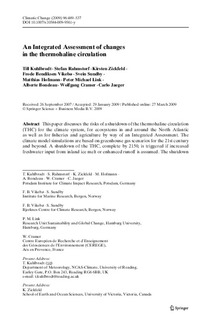| dc.contributor.author | Kuhlbrodt, Till | |
| dc.contributor.author | Rahmstorf, Stefan | |
| dc.contributor.author | Zickfeld, Kirsten | |
| dc.contributor.author | Vikebø, Frode | |
| dc.contributor.author | Sundby, Svein | |
| dc.contributor.author | Hofmann, Matthias | |
| dc.contributor.author | Link, Peter Michael | |
| dc.contributor.author | Bondeau, Alberte | |
| dc.contributor.author | Cramer, Wolfgang | |
| dc.contributor.author | Jaeger, Carlo | |
| dc.date.accessioned | 2010-10-19T13:44:22Z | |
| dc.date.available | 2010-10-19T13:44:22Z | |
| dc.date.issued | 2009-03-27 | |
| dc.identifier.citation | Climatic Change (2009) 96:489–537 | en_US |
| dc.identifier.issn | 0165-0009 | |
| dc.identifier.issn | 1573-1480 | |
| dc.identifier.uri | http://hdl.handle.net/11250/117179 | |
| dc.description.abstract | This paper discusses the risks of a shutdown of the thermohaline circulation (THC) for the climate system, for ecosystems in and around the North Atlantic as well as for fisheries and agriculture by way of an Integrated Assessment. The climate model simulations are based on greenhouse gas scenarios for the 21st century and beyond. A shutdown of the THC, complete by 2150, is triggered if increased freshwater input from inland ice melt or enhanced runoff is assumed. The shutdown retards the greenhouse gas-induced atmospheric warming trend in the Northern Hemisphere, but does not lead to a persistent net cooling. Due to the simulated THC shutdown the sea level at the North Atlantic shores rises by up to 80 cm by 2150, in addition to the global sea level rise. This could potentially be a serious impact that requires expensive coastal protection measures. A reduction of marine net primary productivity is associated with the impacts of warming rather than a THC shutdown. Regional shifts in the currents in the Nordic Seas could strongly deteriorate survival chances for cod larvae and juveniles. This could lead to cod fisheries becoming unprofitable by the end of the 21st century. While regional socioeconomic impacts might be large, damages would be probably small in relation to the respective gross national products. Terrestrial ecosystem productivity is affected much more by the fertilization from the increasing CO2 concentration than by a THC shutdown. In addition, the level of warming in the 22nd to 24th century favours crop production in northern Europe a lot, no matter whether the THC shuts down or not. CO2 emissions corridors aimed at limiting the risk of a THC breakdown to 10% or less are narrow, requiring departure from business-as-usual in the next few decades. The uncertainty about THC risks is still high. This is seen in model analyses as well as in the experts' views that were elicited. The overview of results presented here is the outcome of the Integrated Assessment project INTEGRATION. | en_US |
| dc.language.iso | eng | en_US |
| dc.publisher | Springer Netherlands | en_US |
| dc.subject | thermohaline circulation | en_US |
| dc.subject | termohalin sirkulasjon | en_US |
| dc.title | An Integrated Assessment of changes in the thermohaline circulation | en_US |
| dc.type | Journal article | en_US |
| dc.type | Peer reviewed | en_US |
| dc.subject.nsi | VDP::Mathematics and natural science: 400::Zoology and botany: 480::Marine biology: 497 | en_US |
| dc.subject.nsi | VDP::Mathematics and natural science: 400::Geosciences: 450::Meteorology: 453 | en_US |
| dc.source.pagenumber | s. 489-537 | en_US |
| dc.identifier.doi | http://dx.doi.org/10.1007/s10584-009-9561-y | |
